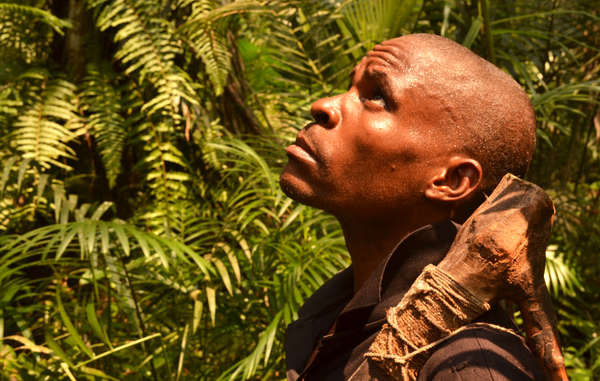
by Deep Green Resistance News Service | Jun 30, 2017 | Colonialism & Conquest
Featured image: Vast swathes of the Bayaka’s ancestral homelands in the Republic of Congo have been taken over without their consent by loggers and big conservation NGOs. © Lambert Coleman
by Survival International
An investigation by Survival International has revealed that the Wildlife Conservation Society (WCS), the parent organization of New York’s Bronx Zoo, is funding the abuse and eviction of Bayaka “Pygmies” and other rainforest tribes in the Republic of Congo.
WCS manages and helped create a national park on Bayaka land without the tribe’s consent, and has formed a partnership with two logging companies working on their land. WCS is also funding anti-poaching squads which prevent the Bayaka from entering their ancestral lands, and Survival International has documented dozens of instances of harassment, beatings and even torture.
The Bayaka are frequently accused of “poaching” when they they hunt to feed their families. Tribal people have complained that this diverts action away from tackling the true poachers – criminals conspiring with corrupt officials.
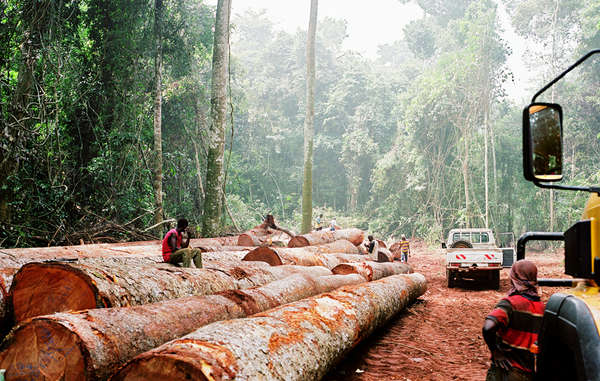
Big conservation has failed to prevent widespread logging on tribal land, and has actively contributed to serious human rights abuses. © Kate Eshelby /Survival
Victims have included children, the elderly and disabled people. In 2012, for example, a severely disabled tribal man was assaulted by guards. In May 2016, one man was hospitalized after he and four others were brutally beaten by guards. Forest camps are frequently destroyed, and tribal people are attacked and tortured for accessing land which they have been dependent on and managed for generations.
A Bayaka man said: “If you go into the park they will get you and take you to prison. Even outside the park they say ‘We’re going to kill you. Get out, get out, get out.’”
Logging in the region continues at unsustainable levels, according to reports by independent researchers and advocacy groups, including Greenpeace. Many observers including the United Nations and Congolese organization l’Observatoire congolais des droits de l’homme, have been warning about the consequences of ecoguard abuse since at least 2004, but no effective action has been taken.
In 2005, a Bayaka man reported that: “We met another white man [from WCS] who came to tell us to stop hunting and that the wildlife guards would make sure we did. Now we are afraid to go far in the forest in case the wildlife guards catch us.”
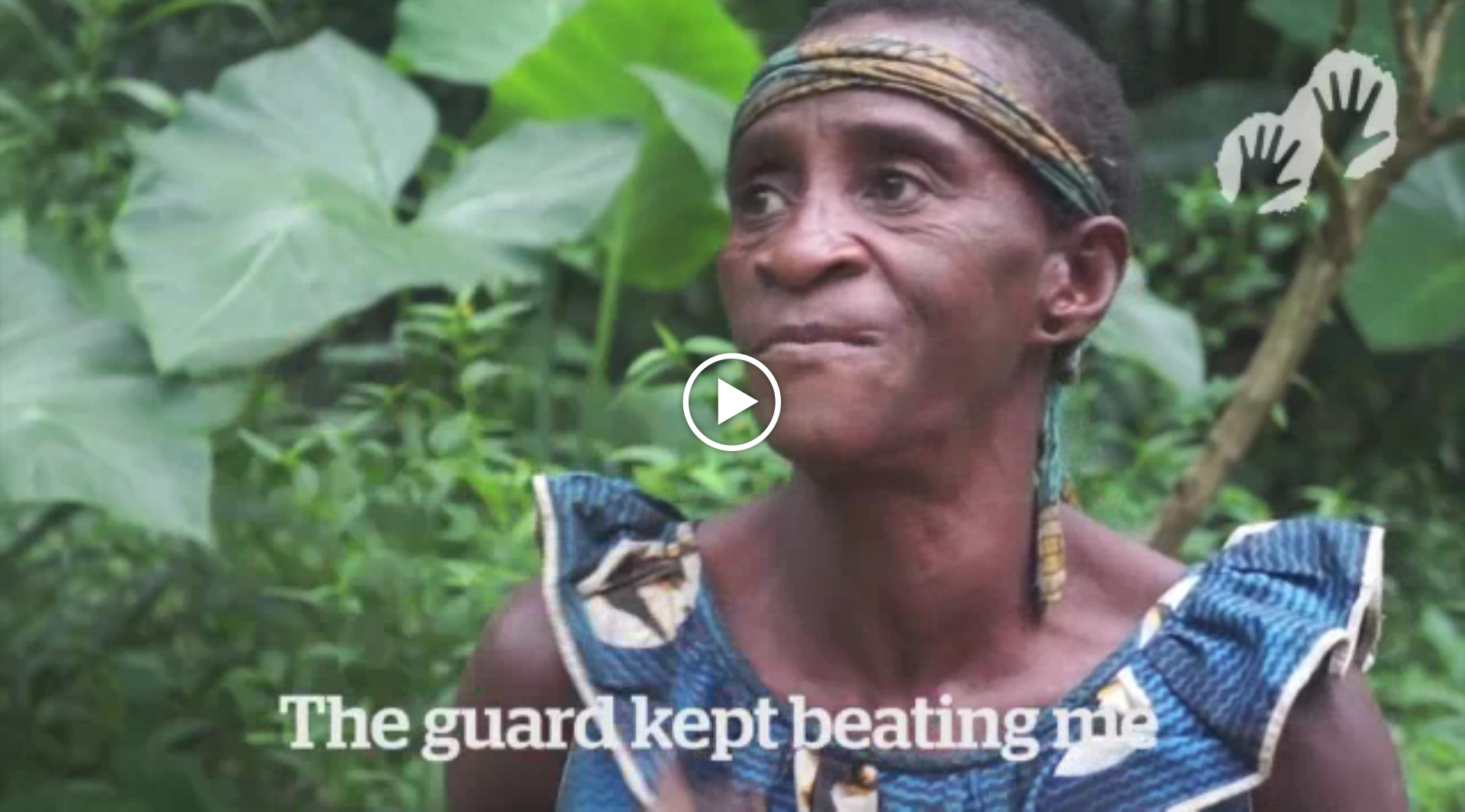
Watch: Apfela describes how wildlife guards, supported by the Wildlife Conservation Society, brutally attacked her.
Survival’s Director Stephen Corry said: “Conservation in the Congo Basin is based on land theft. National parks are created on indigenous peoples’ territories without their consent: It’s land-grabbing (with a “green” label) and the big conservation organizations, like WCS, are guilty of supporting it. Survival International is doing all it can to stop this “green colonialism.” It’s time for conservationists to respect land rights, stop stealing tribal peoples’ ancestral homelands, and obtain proper permission for every project they seek to carry out on tribal land.”
Background briefing
-WCS is one of the world’s oldest conservation organizations, founded in 1895.
-WCS backed the creation of Nouabalé-Ndoki National Park in 1993 without the Bayaka’s consent. It manages the park to this day.
– The organization runs an annual “Teddy Roosevelt Award” for conservation. In 2017, the award generated controversy when it was presented to Gabon’s president Ali Bongo, who has been widely criticized for his government’s record of human rights abuse. According to some reports, Bongo donated $3.5m in exchange for the award.

Madison Grant, notorious eugenicist and founder of the organization which would become the Wildlife Conservation Society (WCS). © Wikimedia Commons
– The Bronx Zoo and the conservation organization that would become WCS were founded by eugenicist author Madison Grant. Infamously, they brought a “Pygmy” man, Ota Benga, to the zoo in the early 1900s. He was exhibited to the public, and encouraged to live in the zoo’s monkey house. He committed suicide in 1916.
– Bayaka people in the Central African Republic and Republic of Congo wrote open letters to WCS and its funders in 2016.
– The abuse of Bayaka by WCS-supported squads has been documented for at least 18 years, but the organization has failed to take effective action to stop it.
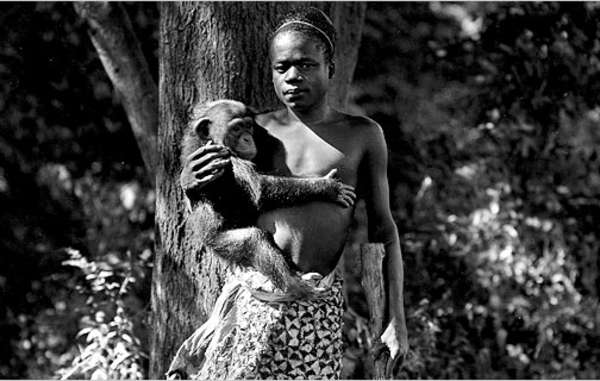
Ota Benga, a Congolese ‘Pygmy’ man who was transported to the US and exhibited in zoos, before committing suicide in 1916. © Wikimedia
WCS is not the only multinational NGO implicated in the abuse of tribal peoples. Many of the big conservation organizations are partnering with industry and tourism and destroying the environment’s best allies.
It’s a con. And it’s harming conservation. Survival International is leading the fight against these abuses, for tribes, for nature, for all humanity.
“Pygmy” is an umbrella term commonly used to refer to the hunter-gatherer peoples of the Congo Basin and elsewhere in Central Africa. The word is considered pejorative and avoided by some tribespeople, but used by others as a convenient and easily recognized way of describing themselves.
Some names have been changed to protect tribal people’s identity.
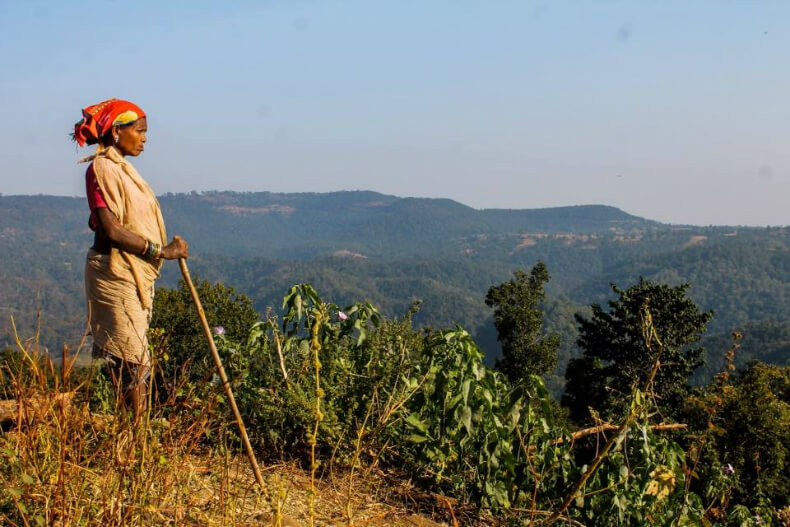
by Deep Green Resistance News Service | Apr 30, 2017 | Colonialism & Conquest
Featured image: A Baiga woman surveys the land in Amaniya panchayat, Chhattisgarh, much of which falls in the area of the proposed tiger corridor between Kanha and Achanakmar National Parks. In the tribal belt of central India, indigenous communities are being manipulated, evicted, and impoverished in the name of conservation. Photo: Heera Bai.
by Heera Bai / Intercontinental Cry
Throughout India today there are a total of 645 Adivasi communities recognized by the government. With a combined population of about 70 million, these communities maintain an impressive array of cultural identities, languages, customs and economies that go back millennia. But despite their resilience and their relative isolation from the perils of extreme extraction, Adivasis—the Hindi term for Indigenous Peoples—have not been able to escape any of the hardships that other Indigenous Peoples so often face around the world.
Across the Tribal Belt of Central India, where 90 percent of the population is still completely dependent on agriculture, indigenous communities are constantly being evicted from their ancestral lands to make way for development projects, industry, tourism and government-sanctioned conservation initiatives.
In the states of Madhya Pradesh and Chhattisgarh, the Baiga community have faced a legacy of evictions that dates back more than 30 years. They are constantly being forcefully, and often illegally, relocated from their fields and villages that live in and around the borders of the Kanha and Achanakmar National Parks.
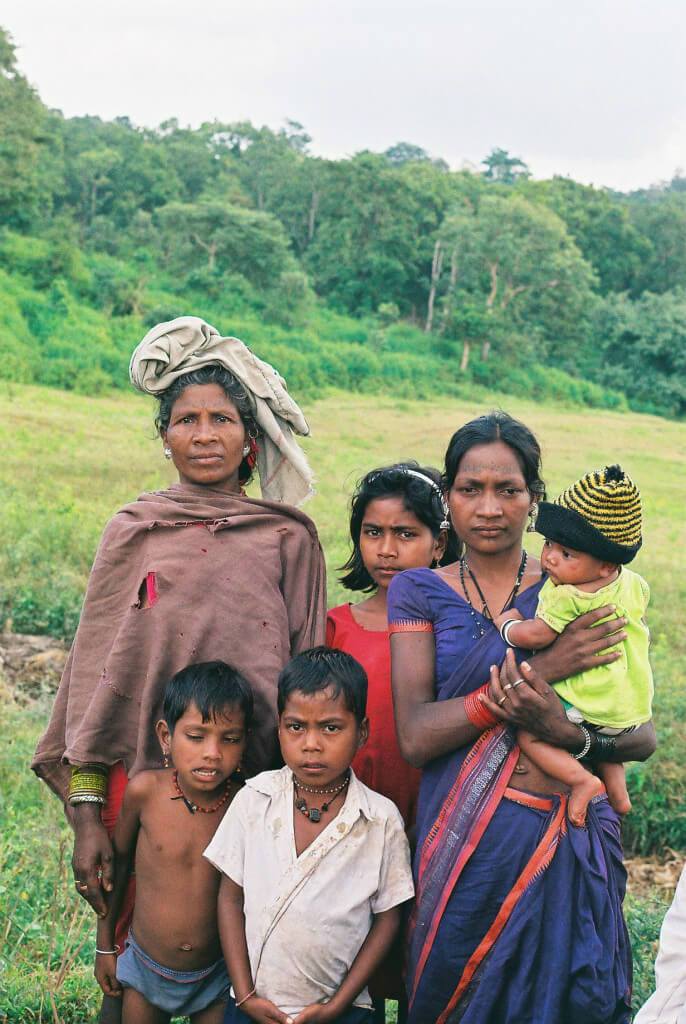
Women from Hirapur, a Baiga village which was relocated from Kanha National Park in the 1970s. “This lush green jungle – we can only see it, but we cant touch it. We cant take anything which was our traditions, our daily bread, it was everything to us. Our rights are written down in a book but we are illiterate.” Photo: Heera Bai
The Baiga are classified as a Particularly Vulnerable Tribal Group (PVTG) by the Indian Government, and the present adult generation had little access to education. The majority are illiterate and know no other language than their regional dialect. Their villages are incredibly isolated, accessible only by foot or motorbike on tracks through the forest. The distance between these villages makes cross-community solidarity or resistance logistically difficult, increasing their vulnerability to exploitation.
Until recently, the Baiga community was dependent on the jungle and the surrounding environment for survival. However, they existed in a symbiotic relationship with the forest generously providing them with everything they need including food, ‘jhari-booti’ (jungle medicine) and wood to build homes and tools. However, after decades of increasing rules and restrictions placed on their access to forest resources and the criminalisation of practices such as ‘bewar’ (shifting cultivation), their way of life has become increasingly difficult to maintain.
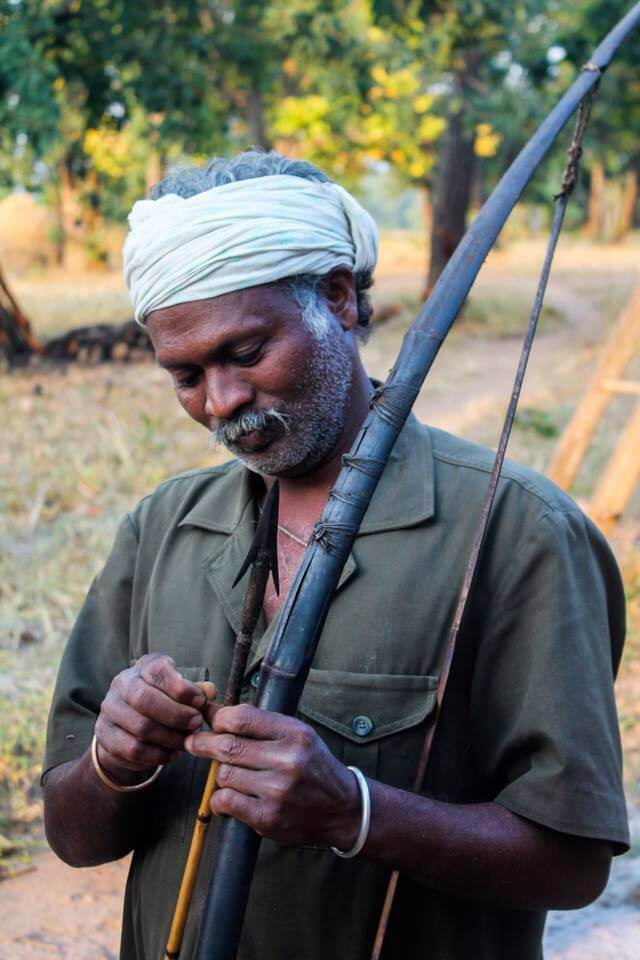
Noonsari, the makeshift village of displaced Baiga adivasi, in Mawai district Madhya Pradesh. This is a dhanoosna, a weapon used by their ancestors for hunting in the jungle. It takes a whole day to make a single arrow from peacock feather and cartilage. Photo: Heera Bai
“For us, only the jungle for us is good,” Bazaari Singh Baiga of the Peepatola village in Chhattisgarh said. “We don’t want fields or houses in another place. We want to stay living in the jungle, we don’t want to move to a city, where would we get wood from? We get everything we need from the jungle. If we moved from here we would die very quickly! We don’t buy things, we take everything from the jungle and make things ourselves with our own hands.”
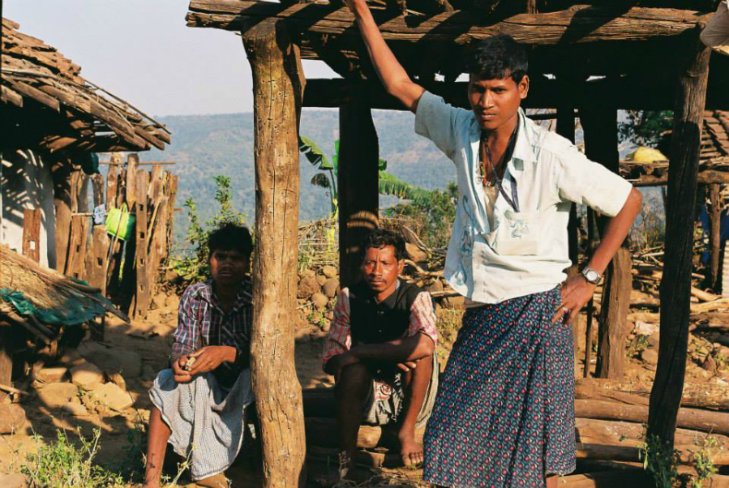
“We don’t want fields or houses in another place. We want to stay living in the jungle, we don’t want to move to a city, where would we get wood from? We get everything we need from the jungle,” says Bazaari Singh Baiga. Photo: Heera Bai
All Baiga villages in Kanha National Park in Madhya Pradesh have been displaced. The evictions began in the 1970s and the last five villages were evicted in 2013. It is a legal requirement that villagers give free, informed consent to the relocation of their village, but consent is forcefully taken after threats, harassment and manipulation.
“The Forest Department came and told us that if we don’t leave willingly they will bring elephants to trample our homes and fields,” Shakti Baiga said. Baiga lived in Benda, one of the last villages in Kanha evicted in 2013. “They brought documents into the village and made us sign it. But we’re illiterate, how could we have known that we were signing our land away?
“I had 5 acres of land in Benda. Here, I could only afford to buy 1.5 acres to support my whole family. I could only afford this land because chances are, this village will be also displaced in the near future. A new [Bhoromdeo] Wildlife Sanctuary has now been created and the fences are starting to go up around the village… There are only two families from Benda here, I don’t see any of the original community anymore.”
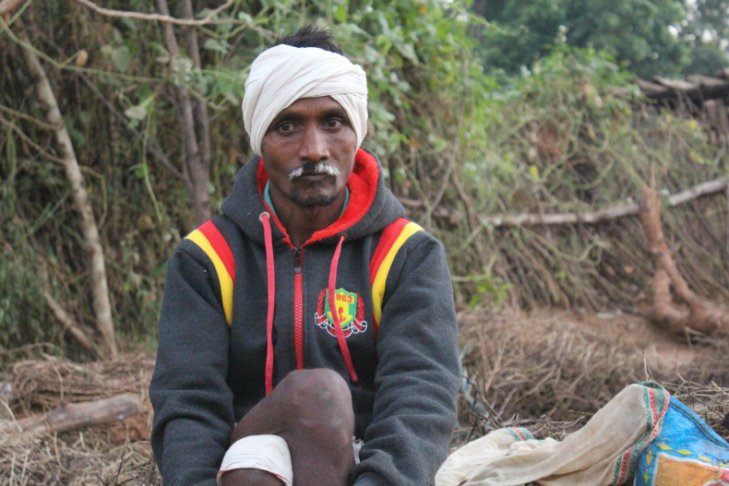
“How could we have known that we were signing our land away?” asks Shakti Baiga. Photo: Heera Bai
There is a strong World Wildlife Federation (WWF) presence in both parks. The infamous panda logo is seen in across the region, from the gates of the national park to small forest villages on the edge of the buffer zone. Despite denying any vested interest in tourism in Kanha, they offer $8,995 ‘tiger tours.’’ Survival International has confronted them about their complicity in illegal evictions in the National Park, but they have denied the illegality of these displacements.
The Forest Rights Act, implemented in 2006, supposedly recognizes ‘any traditional right customarily enjoyed’ by any ‘forest dwelling Scheduled Tribes’ or ‘Traditional Forest Dwellers’. These rights include not only those of forest habitation, but also ‘the right to cultivate for their livelihood, the right to collect minor forest produce, the right to graze cattle, the right to convert leases or grants (pattas) to titles, the right to manage the community forest resources, and the right to enjoy any customary/traditional practice.’
The Forest Rights Act also stipulates procedures for evicting a community from its land. The Panchayat Extension to Scheduled Areas (PESA) means that the Gram Sabha (village level decision making body) must give full, informed consent to the displacement. The community are supposed to be given three options: 1) Reject the eviction and stay on their land, 2) Agree to the eviction, and accept 10 lakh Rs in compensation, or 3) Agree to eviction, and move to a government provided Resettlement and Rehabilitation site.
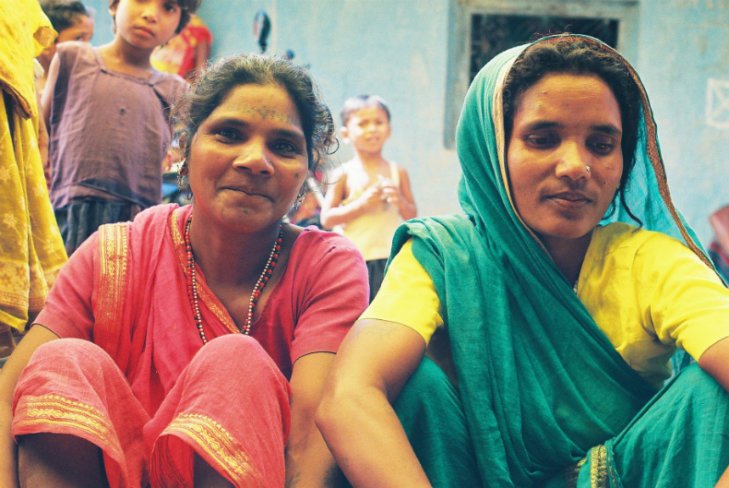
Maki Bai and Sombati Bai from Ajanpur (displaced, now squatting on land in Bhari village, Madhya Pradesh) “All the land that was ours before, where are we going to find that now? We won’t find it. we were the kings of the jungle, but here they treat us like dogs. It’s only sadness here. We can’t even taken wood. Our lives are like dogs!” Photo: Heera Bai
There is no evidence in any of the Baiga villages evicted in the Kanha National Park were given any choice in the relocation, no village was given the option to stay. Even when a rejection is given, this is manipulated; a ‘no’ at the village level gram sabha becomes a ‘yes’ at higher levels of government.
In recent years, the government has run out of state land around Kanha National Park to offer the evicted communities as part of a Resettlement and Rehabilitation package. Villagers from Johar, Benda and the three other villages that were evicted in 2013 received just 10 lakh per adult male, in compensation (women and children under 18 are entitled to nothing). Now, they are struggling to find land that they can afford to buy and the communities have scattered across the region.
In the second park, Achanakmar National Park in Chhattisgarh, there are still 19 tribal villages inside the Core Zone, and many more in the Buffer Zone. So far, five villages have been evicted from the Core, and five more have been given their eviction notice. Those evicted were rehabilitated in resettlement villages on the outskirts of the National Park, where the concrete houses and the dusty road is a far cry from the lush green surroundings they left behind. They were promised five acres of land, a home, a village school and two years of paid work. The fields are drying up after just two harvests, after two years the school building is still awaiting completion and the promised work is yet to materialise. Men of the village are starting to go to distant cities like Lucknow in order to find menial, exploitative daily wage labour.
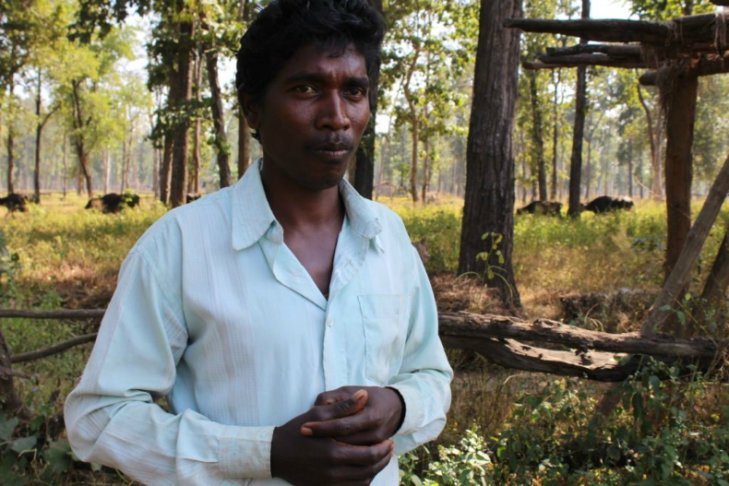
“If we have no choice but to leave Rajak, then we will only be relocated to Jhiriya Behera,” says Ramcharan Baiga. Photo: Heera Bai
Villagers still living in the forest have seen the resettled villages and refuse the offer of relocation. In Rajak, a core zone village, the villagers are unanimous in their rejection of the displaced and the proposed resettlement site. “Of course we want to stay in our village,” Ramcharan Baiga, a residents of Rajak, said. “If we can stay, then we will. We have told the District Collector that we will not go to Bharatpur because the land there is not sufficient to support our families. If we have no choice but to leave Rajak, then we will only be relocated to Jhiriya Behera.” The District Collector is refusing this compromise and insisting that the villagers have no choice in their resettled location.
The National Tiger Conservation Authority (NTCA), Ministry of Environment and Forests, have recently and surreptitiously passed an order stating that:
“In absence (of) guidelines for notification of critical wildlife habitats, no rights shall be conferred in Critical Tiger Habitats which is duly notified under the Wildlife (Protection) Act 1972.”
The Forest Rights Act states explicitly that the rights conferred within apply to all forest areas without exception; therefore the attempt by the NTCA to bypass this is illegal, and will be devastating for the communities affected. There is mounting evidence that suggests that the presence of Adivasis in critical wildlife habitats, including tiger reserves, is in fact conducive to preserving and managing these areas of biodiversity.
In addition to this, there are also plans to create a ‘tiger corridor’ between Kanha and Achanakmar. There are over 700 villages in the proposed area, and many residents do not even hold the most basic land titles. Their evictions will be quick and they will have no grounds to resist. WWF and the state government have assured people that there will be no evictions in the area, but local people do not believe this at all. There are villages about every 7 km in the proposed corridor area, meaning that tigers will not be able to move through the ‘corridor’ without presenting a huge threat to villages. Therefore locals have come to conclusion that the reassurances they have had about there being no evictions are not true.
“That’s what they said when Kanha became a national park, they said the same for Achanakmar. They have already started putting up fences and restricting people’s access to the forest,” said Naresh Bunkar, a local man who was been working with adivasi communities in the region for 30 years. “It’s all lies. Slowly slowly, everyone here is going to be evicted.”
Heera Bai is a freelance journalist who works at Brush & Bow, a platform for creative journalism, working on documenting individual stories through art and music. Follow them at brushandbow.com and on Twitter @brushandbow2
by Deep Green Resistance News Service | Mar 30, 2017 | Colonialism & Conquest
Featured image: Dozens of people have been shot on sight by park guards in Kaziranga, including severely disabled tribal man Gaonbura Killing. © BBC
by Survival International
Survival International has called on the UN expert on extrajudicial executions to condemn shoot on sight conservation policies.
In a letter to the Special Rapporteur charged with the issue, Survival stated that “shoot on sight policies directly affect tribal people who live in or adjacent to ‘protected areas’… particularly when park guards so often fail to distinguish subsistence hunters from commercial poachers.”
The letter adds that “nobody knows when wildlife officers are permitted to use lethal force against [suspected poachers], and it is impossible for dependents to hold to account officers whom they believe to have killed without good reason. Many countries have gone further, and granted wildlife officers immunity from prosecution.”
The letter cites Kaziranga National Park in India as an especially striking example of the tactic. According to a recent BBC report, an estimated 106 people have been extrajudicially executed there in the last 20 years, including one disabled tribal man who had wandered over the park boundary to retrieve cattle.
Kaziranga guards have effective legal immunity from prosecution, and have admitted that they are instructed to shoot poaching suspects on sight. This has had serious consequences for tribal peoples living around the park. In June 2016, a seven-year-old tribal boy was shot and maimed for life by guards.
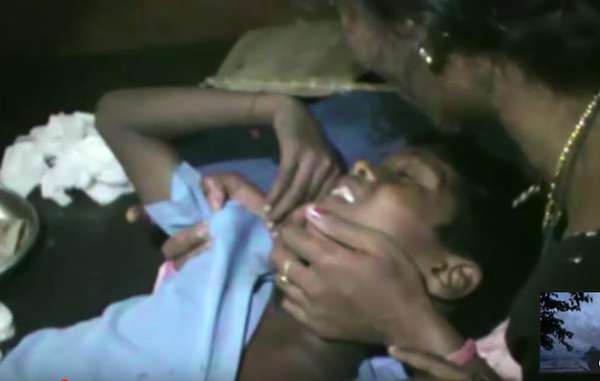
Akash Orang is comforted by his mother after being shot by a park guard. He is now severely disabled. © BBC
Similar policies are used in other parts of the world, notably Kenya, Tanzania and Botswana, among other African countries.
Speaking about his own anti-poaching work in Africa, poaching expert Rory Young from the organization Chengeta said: ”Shoot on sight is stupid. If we had been shooting on sight during this latest sting operation we would have shot a handful of poachers and that would have been the end of it. Every single poacher is an opportunity for information to get more poachers and work your way up the chain to the ringleaders.”
Survival has asked the Special Rapporteur to clarify that shoot on sight violates fundamental rights enshrined in the UN’s Civil and Political Rights Covenant and other international conventions. It also urges the UN to enquire about the policy with the Indian government, and the government of Assam state, where Kaziranga is located.
Shoot on sight is justified on the grounds that it helps to deter poachers. However, there have been several recent cases of guards and officials at Kaziranga being arrested for involvement in the illegal wildlife trade themselves.
Survival International is leading the fight against these abuses, and calling for a new conservation model that respects tribal peoples. Targeting tribal people diverts action away from tackling the true poachers – criminals conspiring with corrupt officials. Targeting tribal people harms conservation.
Survival’s Director Stephen Corry said: “If any other industry was guilty of this level of human rights abuses, there would be an international outcry. Why the silence when conservationists are involved? Torture and extrajudical killing is never justified – the law is clear on this. Some people think that the death of innocents is justified, that ‘collateral damage’ is necessary in the fight against poaching. We ask them, where is your humanity? Of course, there’s a racist element at play here: Shoot on sight policies would be unthinkable in North America or Europe.”
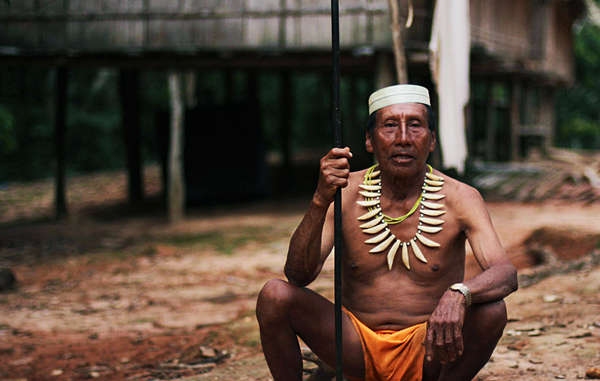
by Deep Green Resistance News Service | Mar 10, 2017 | Lobbying
Featured image: The Matsés have denounced oil exploration in the proposed Yavarí Tapiche reserve, which is part of their ancestral lands. © Survival International
by Survival International
In an open letter to the Peruvian authorities, Survival International, Rainforest Foundation Norway and Peruvian indigenous organization ORPIO have denounced the Peruvian government’s failure to protect uncontacted tribes.
The organizations are calling for the government to create an indigenous reserve, known as Yavari-Tapiche, for uncontacted tribes along the Peru-Brazil border, and to put a stop to outsiders entering the territory.
In the letter the three organizations state: “Uncontacted tribes are the most vulnerable peoples on the planet. They have made the decision to be isolated and this must be respected…
“The Yavarí Tapiche region is home to uncontacted peoples. Despite knowing of their existence and enormous vulnerability, the government has failed to guarantee their protection…
“These tribal peoples face catastrophe unless their land is protected. Only by creating the proposed Yavarí Tapiche indigenous reserve and implementing effective protection mechanisms that prevent the entry of outsiders, will the indigenous people be given the chance to determine their own futures…
“We are also concerned about the government’s refusal to exclude oil exploration within the proposed reserve…. No exploration or exploitation of oil should ever be carried out on territories inhabited by uncontacted Indians…
“We believe that the oil company Pacific Stratus is poised to begin operations this year in areas where there are uncontacted tribes…
“By failing to both create the reserve and to rule out oil exploration, Peru is violating both domestic and international law…
“If the government does not act urgently to protect the uncontacted peoples of Yavarí Tapiche, we fear that they will not survive. Another tribe will disappear from the face of the earth, before the eyes of the world.”
Survival’s Director Stephen Corry said: “We’ve repeatedly called for the Yavarí-Tapiche indigenous reserve to be created and for oil exploration to be ruled out, but the government has dragged its feet. The lives of uncontacted Indians are on the line but once again, economic interests take priority.”
Background Briefing
– The Yavarí Tapiche region is part of the Amazon Uncontacted Frontier. This area straddles the borders of Peru and Brazil and is home to more uncontacted tribes than anywhere else in the world.
– Pacific Stratus, part of Canadian oil company Pacific E&P, began its first phase of oil exploration in 2012, despite protests from indigenous organizations and Survival International. It is believed that the company will begin its second phase soon.
– Oil exploration is devastating for uncontacted tribes. Over 50% of the Nahua tribe died as a result of exploration in the 80s.
– The indigenous organization ORPIO is suing the government over the threat of oil exploration.
– National indigenous organization AIDESEP has been calling for the creation of the reserve for over 14 years.
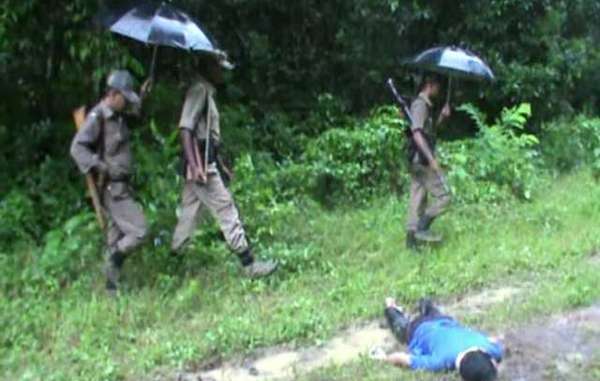
by Deep Green Resistance News Service | Feb 16, 2017 | Colonialism & Conquest
Featured image: Kaziranga park guards are heavily armed and instructed to shoot intruders on sight. © Survival International
by Survival International
A BBC investigation has revealed that tribal peoples living around a national park in India are facing arrest and beatings, torture and death under the Park’s notorious “shoot-on-sight” policy.
The report for television, radio and the BBC news website featured interviews with park guards, tribal people who have been affected by the policy in Kaziranga National Park, and a spokesman from WWF-India, which helps fund, train and equip park guards and advertises tours of the park through its website.
The park gets over 170,000 visitors each year. Fifty suspects were extrajudicially executed there in the last three years, and a severely disabled tribal man was shot dead in 2013. The BBC has estimated that 106 have been killed in the last 20 years. In the same period, only one official has been killed.
The BBC interviewed one local man who had been beaten and tortured with electric shocks during a detention by park officials before they realized he had no involvement in poaching.
The program also featured Akash Orang, a seven-year-old tribal boy who was shot in the legs by park guards last July. Akash said that: “The forest guards suddenly shot me” as he was on his way to a local shop. His father said: “He’s changed. He used to be cheerful. He isn’t any more. In the night, he wakes up in pain and he cries for his mother.”
Park guards have effective immunity from prosecution and are encouraged to shoot suspects on sight – without arrest or trial, or any evidence that they might have been involved in poaching. One guard admitted that they are: “Fully ordered to shoot them, whenever you see the poachers or any people during night-time we are ordered to shoot them.”
WWF has provided equipment – including what the BBC calls “night vision goggles” – which have been used in night-time operations and “combat and ambush” training. When asked by the BBC how donors might feel about their money being used to enforce this brutal treatment, WWF India’s spokesman said that: “What is needed is on-ground protection… We want to reduce poaching and the idea is to reduce it with involving other partners.”
Survival International is leading the global fight against these abuses and first brought the park’s high death toll and serious instances of corruption among Kaziranga officials – including involvement in the illegal wildlife trade they are employed to stop – to global attention in 2016.
Survival’s Director Stephen Corry said: “Conservation organizations, including WWF, are supporting a model of conservation which is resulting in gross human rights abuses. They have failed to condemn policies that are leading to widespread extrajudicial executions. For too long, conservation has relied on its positive public image to hide its horrific and sustained attacks on indigenous and tribal peoples’ rights. We’re working to stop this. It’s time for conservationists to work with tribal people, the best conservationists and guardians of the natural world. It’s time for conservation organisations to call for an end to shoot on sight policies.”















